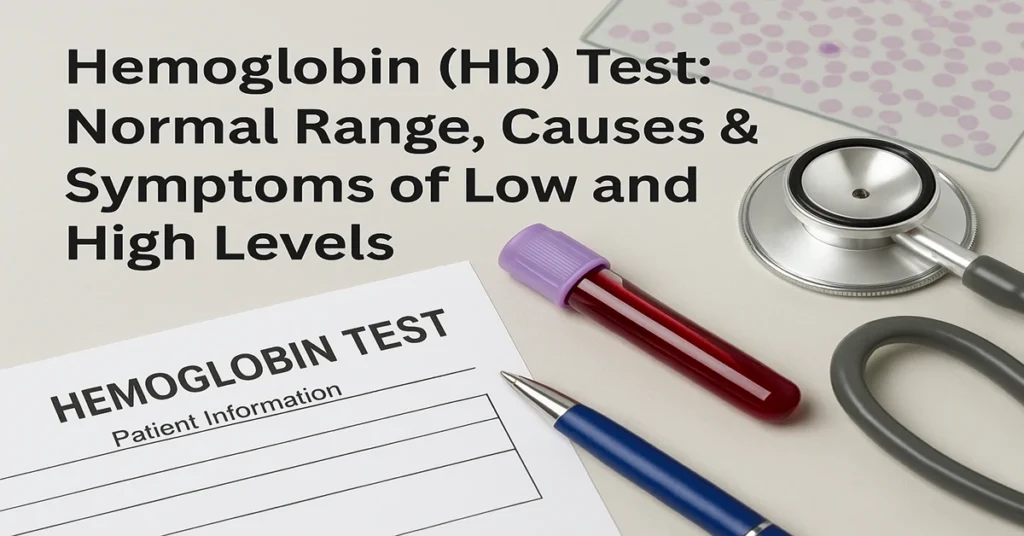What is Hemoglobin (HB)?
Hemoglobin (Hb) is a test that measures how much hemoglobin protein is present in your blood. Hemoglobin itself is a red-colored protein found inside red blood cells (RBCs). Its main job is to carry oxygen from your lungs to every part of your body and bring back carbon dioxide to the lungs so that you can breathe it out.
Without enough hemoglobin, your body does not get the oxygen it needs, which can cause weakness, tiredness, and many health problems. This is why the hemoglobin test is one of the most common blood tests done in hospitals and labs.
Where is Hemoglobin Synthesized in the Body?
Hemoglobin is made inside the bone marrow, the soft spongy tissue present inside bones like the ribs, spine, pelvis, and long bones. In the bone marrow, special immature blood cells called erythroblasts develop into red blood cells. During this process, hemoglobin is produced and filled inside the cell.
When the red blood cells mature, they are released into the bloodstream with hemoglobin already present in them. Since red blood cells live for about 120 days, the bone marrow keeps making new ones to maintain normal hemoglobin levels.
Main Functions and Importance of Hemoglobin
- Oxygen Transport: Hemoglobin picks up oxygen in the lungs and delivers it to tissues and organs.
- Carbon Dioxide Removal: It helps carry carbon dioxide waste from tissues back to the lungs.
- Maintains pH Balance: Hemoglobin helps in keeping the blood’s pH in the normal range.
- Supports Energy Production: By supplying oxygen, it allows the body to produce energy for daily activities.
If hemoglobin is too low, oxygen supply drops, and the body feels weak. If it is too high, blood becomes thick and can cause other health risks.
Causes of Low Hemoglobin (Anemia)
When hemoglobin levels fall below normal, it is usually called anemia. Some main causes are:
- Iron Deficiency: The most common cause, often due to poor diet, blood loss, or heavy periods.
- Vitamin Deficiency: Especially lack of Vitamin B12 or folic acid.
- Chronic Diseases: Kidney disease, cancer, tuberculosis, or HIV can lower hemoglobin.
- Bone Marrow Disorders: Conditions like aplastic anemia and leukemia reduce RBC production.
- Blood Loss: After accidents, surgery, internal bleeding, or regular heavy menstruation.
- Genetic Disorders: Sickle cell anemia and thalassemia affect the shape or production of hemoglobin.
Symptoms of Low Hemoglobin (Anemia)
- Constant weakness or tiredness
- Pale or yellowish skin and lips
- Shortness of breath even after small effort
- Fast or irregular heartbeat
- Dizziness or frequent headaches
- Cold hands and feet
- Poor concentration and reduced focus
If anemia is not treated, it can affect the brain, heart, and overall health.
Causes of High Hemoglobin (Polycythemia)
High hemoglobin is less common but also important to identify. This condition is often called polycythemia. Causes include:
- Living at High Altitudes: Less oxygen in the air pushes the body to produce more hemoglobin.
- Smoking: Increases carbon monoxide in blood, and the body produces extra hemoglobin to compensate.
- Lung Diseases: Conditions like COPD (chronic obstructive pulmonary disease) and pulmonary fibrosis.
- Heart Diseases: Some heart defects cause poor oxygen levels in blood.
- Dehydration: Low fluid levels make hemoglobin concentration appear higher.
- Polycythemia Vera: A rare bone marrow disorder where the body makes too many red blood cells.
Symptoms of High Hemoglobin
- Headache and dizziness
- Itching, especially after a warm bath or shower
- Red or flushed skin
- Nosebleeds
- Blurred vision
- High blood pressure
- Risk of blood clots, which can lead to stroke or heart attack
Reference Ranges (may vary slightly by laboratory)
Men: 13.8 – 17.2 g/dL
Women: 12.1 – 15.1 g/dL
Children: 11.0 – 16.0 g/dL
Pregnant Women: Around 11.0 g/dL or more
Sample Type
- Sample Taken: Whole Blood
- Tube Used: Lavender Top (EDTA tube)
The test is usually done by taking a small sample of blood from a vein in the arm. It is quick, safe, and results are often ready the same day.
Test Preparation
- Normally no fasting is required before a hemoglobin test.
- Drink enough water before the test because dehydration may temporarily raise hemoglobin levels.
- Tell your doctor about any ongoing medicines like iron tablets, blood thinners, or chemotherapy drugs.
- Sometimes doctors order a hemoglobin test along with a Complete Blood Count (CBC) for more detailed results.
When to Consult a Doctor
- If you feel tired, dizzy, or short of breath without a clear reason.
- If you have pale skin, frequent headaches, or nosebleeds.
- If your hemoglobin test shows levels consistently below or above the normal range.
- Pregnant women, people with kidney or lung diseases, and those with a family history of anemia or polycythemia should consult doctors regularly for hemoglobin checks.
~END~

